Bringing heavy support to airborne troops
The NONA Новейшее Орудие Наземной Артилерии or "Newest Ordnance of Ground Artillery", designated 2S9 in the soviet self propelled artillery nomenclature was an extremely light-weight self-propelled, air-droppable 120 mm gun-mortar. Entering service in 1981 an estimated over 1,000 were built.After the ASU-57, ASU-85, and more modern BMD-1 IFV and BTR-D this was the next logical step to provide the needs of the paratroopers in the classic doctrine of "deep battle".
The 2S9 basic idea was first drafted when proposals of conversion of the BMD chassis were made. The goal was to develop a vehicle that could replace the hand-loaded, indirect-fire M-1943 120-mm mortar used in the Airborne battalions, which was tracted by lightweight vehicle but lacked protection. The 120-mm 2S9 Anona (Anemone) self-propelled combined howitzer/mortar was first seen in public in May 1985, developed to replace also both airborne existing mortars and howitzers. It was even developed as a direct anti-tank weapon system, using HEAT shells.
This self-propelled mortar derived from many experiments made in the Second World War already and as used in the Wehrmacht as advanced reconnaissance organic artillery. The United States also experiented with the concept and notably designed the "Gorilla" used in Korea. However, in majority they were conventionally, manually muzzle-loaded field mortars. In USSR the conept was studied in 1942 already. Self-propelled mortars were tested on VG Grabin's design 107 mm ZIS-26 (1942) and 50 mm S-11 mortar (1943). But they never left the design stage.
In the mid-1960s the concept resurfaced again as the 120-mm mortar was asked in the wide range of tasks performed by airborne forces, but the wight of the system put the operators, which were surrounded in operations, to dangerous exposition. Thus, tactical, specific plans were made for a preemptive strike from airborne group in the "Palatinate Triangle": The jonction between Germany with France and the Netherlands. This area well behing enemy lines was the depot region for all advanced American divisions deployed in Germany notably. The goal was to seize and destroy these stockpiles. It was estimated in this scenario Soviet airborne forces could face opposition from 2-3 rearguard divisions of the Bundeswehr. it was estimated that to deal with them, a force using BMDs should be of the same order that of the motorized rifle division, using the heavier BMP.
In the late 1950s, massive numbers of small, tactical nuclear weapons changed planning for military operations. A larger role was assigned to the airborne troops, that were to intervene after a nuclear strike. Until the 1960s, their equipment diverged little from the divisions of the Great Patriotic War, but the new situation required a serious reorganization and re-equipment. The new specialized vehicles to be developed were to be carried and deployed by the AN-8 and AN-12 aircraft. With a larger internal volume, greater load capacity they could accept larger vehicles and this was crystallized in the Airborne Armament Program of 1964. Work started to determine tactical and technical requirements for all equipments of the Airborne Forces and the section devoted to the airborne mortar system was initially the Krymsk Central Research Institute of Precision Machinery.
The ammunition was developed meanwhile by SNPP "Basalt" and the gun designed at Sverdlovsk DB-9 (lead designer VA Golubeva). The OKB-9 however was later retired this program, appointed instead to the Special Design Bureau of N°172 plant, Yu.N. Kalachnikov. The basic chassis was to be designed and manufactured by the Volgograd Tractor Plant, but the latter refused to assemble the mortar, therefore Perm plant No. 172 was chosen to create the intermediate turret, mount, and final assembly of the 2S9.
In 1964, France, Thomson-Brandt's mass produced 120-mm RT-61 rifled mortar started to fill all NATO units and became a subject of study for Soviet analysts. The mortar used the classic imaginary triangle scheme and had a greater weight and better precision. Its ammunition stand out as having ready-made protrusions on the leading belts, and it was deemed as effective as the standard 155-mm HE shell used by NATO. By the early 1980s, the RT-61 mortar was in service with thirteen countries and USSR took notice.
Soon, the Central Research Institute of Precision Engineering was instructed to create emulate the RT-61 and create a similar rifled mortars. This Klimovsk instituted located near Moscow had a department created by V. A. Bulavsky, specialized in artillery systems, which greatly helped this new development, which also meant the current 2S9 design was to be deeply reworked. The final mortar was developed under the direction of A.G. Novozhilov, later integrated into NPO "Basalt". They eventually delivered a copy of the 120-mm Brandt RT-61 and with ammunitions, tested in many configurations. These tests confirmed that the rifled solution for a mortar was about at least two times superior to an ordinary system. In 1976, the Perm Plant was involved in the 120-mm rifled mortars, under supervision of R. Ya. Shvarov and A. Yu. Piotrovsky. They designed the final production model which received the index GRAU 2 A51. In 1981,Shvarev and Piotrovsky even became laureates of the State Prize.
The system developed was in fact a combined mortar, howitzer, and anti-tank gun. It performed all the functions at once with a single barrel, and adjustments in settings for the receiving system and breech block, as well as an ammunition management system. In service manuals and technical descriptions of the time, the 2A51 was called a universal weapon system, able to fire shaped-charge anti-tank shells, rotating high-explosive fragmentation shells and all types of 120-mm ordnance produced in USSR at the time. It gavce the paratroopers on paper an unparallel versatile support on the ground, something the BTD nor the BTR-D could nor provide. It was even able to fire the French and NATO mortar standard 12 cm ammunition compatible with the RT-61 and assimilated ordnance, making it perfect for export sales. The integration and production of the first 2S9 was perfected the same year and the vehicle field tested in 1980, then approved for service and mass production in 1981.
Design
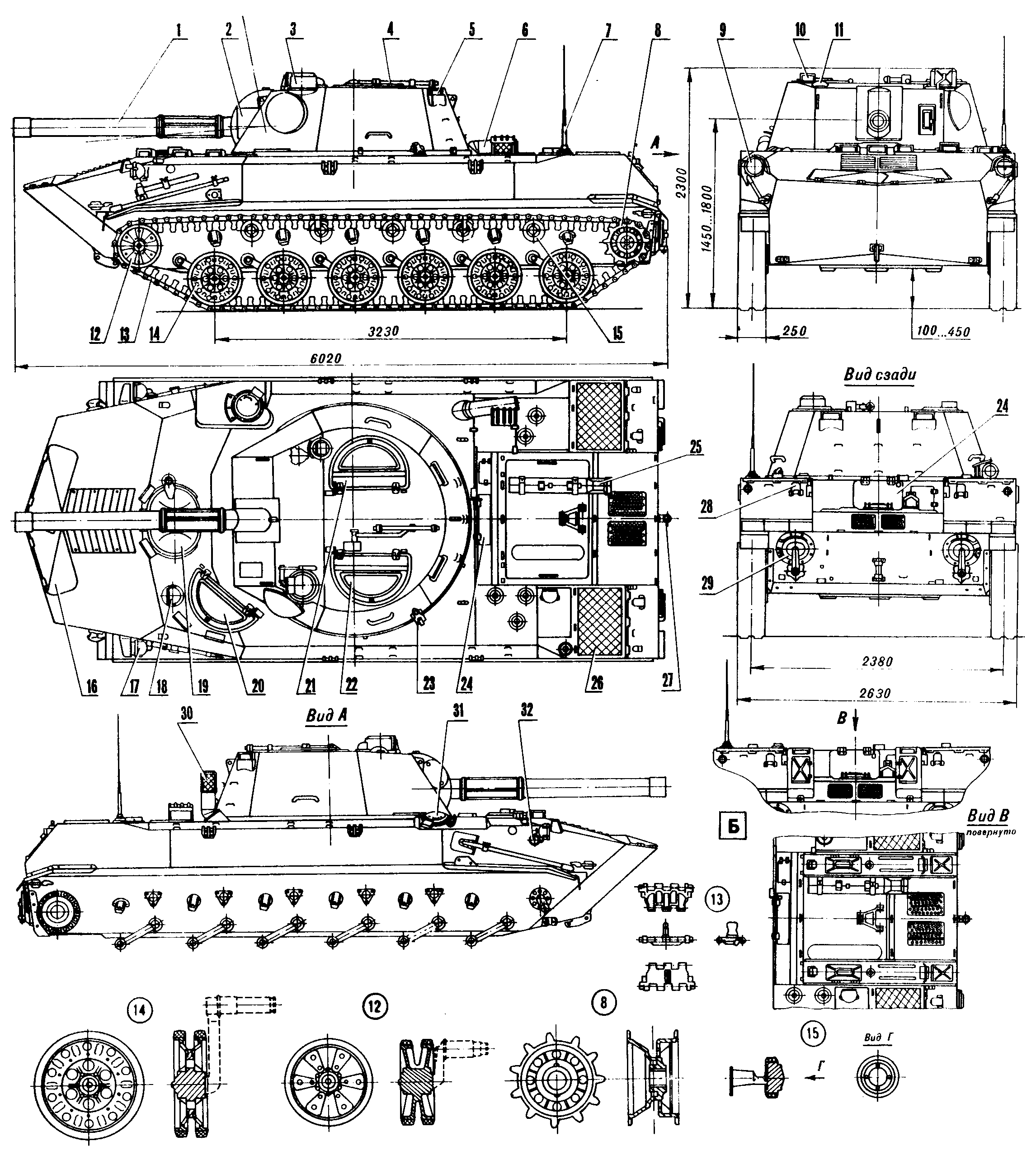
The 2S9 chassis is designated S-120, based on the aluminium hull of the BTR-D airborne APC (article there). The standard-issue 120 mm mortar was generally referred to as the Nona, so in precise nomenclature, the 2S9 was differenciated as Nona-S.
It had a four-man crew (commander, driver/mechanic, gunner, loader). The 2S9 hull is a stretched version of the BMD, divided into three compartments.
Hull & Protection
The hull interior is separated into a command, fighting and engine compartments. Above the BTR-D based chassis, there is a large ring, with a welded steel turret on top, roughly at the middle of the hull. It is a two-man turret with hatches for the gunner and loader. So the vehicle is also protected with collective NBC, with spall lining and overpressure. This is also required for the vehicle's amphibious requirements.It was made of welded steel construction with 16-mm thick frontal armor, 15 mm elsewhere and lower, ensuring protection against small arms fire and artillery shell splinters. The turret roof has two hatches, one for the gunner and the other for the loader. The vehicle measured 6.02 m long for 2.63 m in width, and 2.3 m height, all the same as the BMD and BTR-D, so it eased standardization for air transport a great deal. The 2S9 weighted 8,000 empty and up to 8,700 kg fully loaded. Armor protection was limitd to 15mm (max) and in Aluminum; Due to the slope of the nose, artificially equivalent to 30-35 mm. The main problem with aluminium however was the inflamability risk posed due to magnesium amount in the composition. It is likely that an alloy was rather used, but it's only conjectural. In any case, there are automatic fire suppressing systems in all thre compartments.
Motorization
The 2S9 was provided a 5D20 Diesel rated for 240 hp, with a Power to weight ratio of 27.1 hp/tonne. The tracks, roadhweels, drive sprocket, idlers, and torsion bar suspension system were the same used on the BMD Airborne combat vehicle. The driver is provided a Night Vision Equipment, swappable infrared sight.Mobility
The 2S9 Nona-S is basically an airborne, lightweight and amphibious vehicle propelled through the water by two rear water-jets. Its top speed on road was 60 kph, and it could swim at 9 kph. It is given a fuel Capacity of 400 liters, and its Max operational Range is 500 km. The 2S9 was tested and proved able to climb a gradient of 60%, a side slope of 30%, gap a trench 1.8 to 2m wide, manage a vertical step up to 80 cm high, climb a 31° slope and running along a 19° side slope. Its ground clearance was 450 mm and as other vehicles using the same chassis, the sustemsion system allowed the chassis to be lowered to the extreme to be loaded on a palette.Armament
The 2S9's 120mm 2A51 mortar had a 1.8-meter-long barrel, rifled, breech-loaded. Apart antitank ammunitions, including HEAT and APDSDS, it is also capable of using laser-guided munitions like the KM-8 Gran with a setup for the pointer/gunner allowing him to engage both in indirect and direct fire with a simple switch. Targeting armoured vehicles was indeed a welcome addition to the arsenal deployed by the paratroopers, although derivatived of the BTR-D as tank hunters used antitank missles for a better range. The armour-piercing (AP) rounds tested were able to penetrate a 600-650mm steel plating RHA at about 1,000 m. So heavy punch but dangerously short range. As beffitting paratroopers, this was a close quarter defensive weapon system.The rifled barrel wedge breechblock is coupled with a semiautomatic system. The barrel shared many elements with Soviet conventional artillery. The barrel has 40 grooves of constant slope. recoil is absorbed by using pneumatic cushion. Compressed air is blown through the barrel to remove excess powder gases when the bolt is opened (muzzle evacuator). Two cylinders are installed forward of the turret and the circulation of air is automatic, using a standard air compressor coupled with the engine start. The recoil system is a conventional one, with an hydraulic spindle-type recoil brake, hydropneumatic knurler.
The mortar range was 8.8 km, extended to 12.8 km with special charges, and 0.8 km in direct fire (with HEAT ammunition for example). The ammunition types carried were considerable and unparralleled: HE-Frag, Frag-RAP, laser guided, HEAT-FS, Illumination rounds, Smoke rounds, Incendiary rounds, Chemical rounds, Flechette (APFSDS). The mount procured an elevation of -4 to 80°, a traverse 70°, with a rate of fire of 10 rpm on average, 4 sustained, and the vehicle's usual load was 40, up to 60 rounds, but it was only for quick operations. BTR-D specially fitted to carry extra loads were to follow them.
Production and fate
Since no figure has been divulgated, NATO analysts thinks their number is over 1,000, notably based on what is known of the paratrooper units organization and organic strenght in the 1980s. It is however now a 40+ years old system and is currently upgraded using the M Nona-SM modernization kit, while also scheduled for replacement in the long run, in the 2020s by the 2S42 Lotos. Due to its widespread use by many countries, it is likely local variants would be developed in the future.Variants
Variants and derivatives of the 120 mm Nona mortar:- 2S9-1 Sviristelka: Developed for naval infantry with an ammunition load of 40 rounds (1988)
- 2S9-1M Nona-SM: Upgraded russian version of the Nona-S: New fire control system, satellite navigation (2007), and upgrade kits are provided as standard, aso to be ported to the 2S9-1 Sviristelk.
- 2B18 Nona-M experimental towed mortar.
- 2S23 Nona-SVK: A BTR-80 based version. It uses a slightly modified version of the 2A51 mortar, designated 2A60, and turret. Used by Russia as a fast deployed vehicle.
- 2B16 Nona-K towed version (1988). Fitted with a muzzle brake.
- 2S42 Lotos, Russian development revealed in 2019. Longer chassis, more ammunition, better protected, production scheduled for 2020 as main replacement for the 2S9 Nona-S.
- 2S31 Vena, similar concept based on the BMP-3 chassis. Longer barrel for increased range.
Operators
⚑ Azerbaijan: Eighteen vehicles⚑ Belarus: Forty eight vehicles
⚑ China: Possibly one tested, no production known, but China introduced two artillery systems based on the same 120 mm breech-loaded mortar.
⚑ Kazakhstan: Tewnty-five vehicles.
⚑ Kyrgyzstan: Twelve vehicles.
⚑ Moldova: Nine vehicles.
⚑ Russia: More than 780 (plus an estimated 500 in store) 2S9 Nona-S. Also 42 2S23 Nona-SVK and 124 2B16 Nona-K
⚑ Syria: Some passed on by Russia during the civil war, unknown quantities.
⚑ Turkmenistan: 203 2S9 as successor state
⚑ Ukraine: Two 2B16 and forty 2S9. They saw action on both sides during the War in Donbas
⚑ Uzbekistan: 54 as successor state
⚑ Venezuela: 18 Nona SVK ordered in 2009 and delivered 2011-2012. 13 in service in 2016.
Combat use
In the Afghanistan war, the 2S1 122mm self-propelled howitzer and 2S9 120-mm self-propelled howitzer/mortar were found very useful in this muntainous terrain in support raiding motorized rifle or air assault forces. They were deployed by battery or battalions, and prior to the raids, Soviet planners determined initial targets from reconnaissance. The vehicles usually fired a 3 to 5 minute artillery preparationand if the Mujahideen opened fire during the raid, Soviet gunners attempted to quickly engage the newly located target before it could escape, also noting their position. After 1-2 ranging rounds mass artillery fire followed on the newly pointed target using firing tables for suppressive artillery.During pitched battles Soviet forces usually pursued withdrawing Mujahideens, which generally left rear guard for delaying actions. This rear guard was generally too close for comfort, about 200-300 meters so both neither Soviet air or artillery could engage them without high risks of "blue on blue" accidents. The Soviet forward observer of a 2S9 however to the short range of the system was able to strike them.
The vehicle was also used by Russian forces in the Chechen Wars. Its great advantage is to be able to engage targets not accessible to standard artillery systems and howitzers, because of very high elevation range. It is usable in urban and mountainous areas. Othr deployments includes the Donbass, Syria, and the Armenian-Azerbaidjan war (2020 Nagorno-Karabakh war).
Related links & resources
On globalscurity.orgwalkaround photos
On military-today
www.strategic-bureau.com
weaponsystems.net
weaponews.com
tvd.im
soldat.pro
armyrecognition.com
war-book.ru
Model Kit
2S9 specifications | |
| Dimensions (L-w-h) | 6 x 2.3 x 2m |
| Total weight, battle ready | 8.7 tonnes |
| Crew | 4 |
| Propulsion | 5D20 Diesel 240 hp |
| Speed (land/water) | 60 kph - 9 kph |
| Range (on flat) | 500 km |
| Armament | 120 mortar-howitzer, see notes |
| Armor | 16 mm max RHA |
| Total production | 1,000+ |
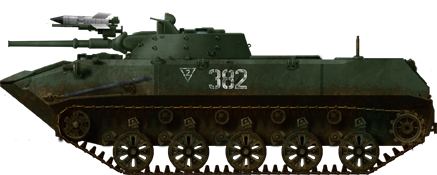
BMD-1, for comparison
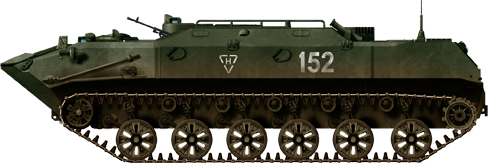
BTR-D for comparison
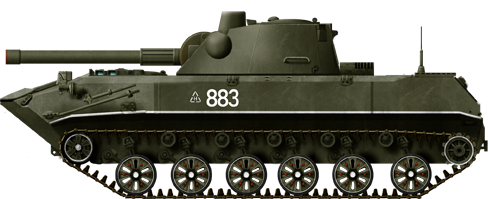
Regular green 2S9 in parade colors

2S9 in provisional winter paint, Russia 2000s
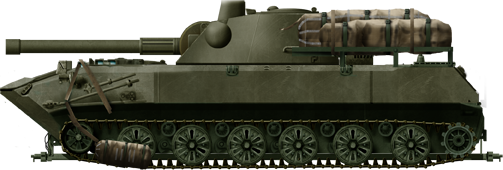
2S9 as loaded on a palette for airdrop.
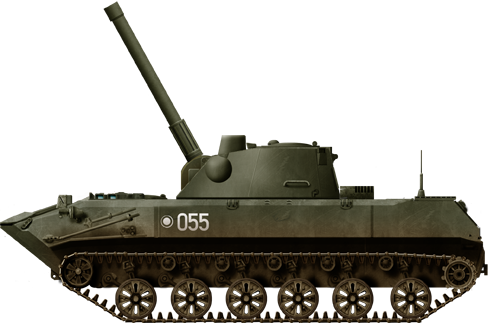
2S9 with max elevation
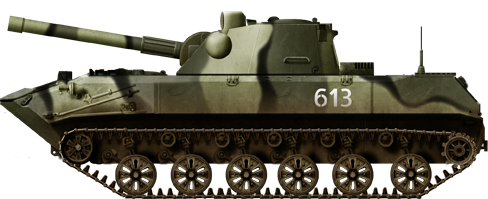
2S9 M1 Nona-S used by the Russian Army
Videos
Russian 2S9 Nona-S Self-propelled air-droppable artillery, La Magra channelSoviet army footage
Same here.
On armored warfare
Extra photos

Vehicle kept at St Petersburg.


Modern Vehicle used by the Russian Army;

Test Vehicle kept at the Perm plant.

2S9 in parade in the 2000s, red guards unit. credits: military today

SFOR vehicle at maximal elevation and chassis down, same src

2S9-1 Sviristelka in amphibious manoeuvers, same src

Vehicle configured for air transport and paradropping, Amrmiya 2020 expo

Rehearsal at tula 2017

2B16 gun howitzer, towed

Cold War Tanks


































Cold war tanks posters

Cold War Main Battle Tanks

Cold War Soviet Army


